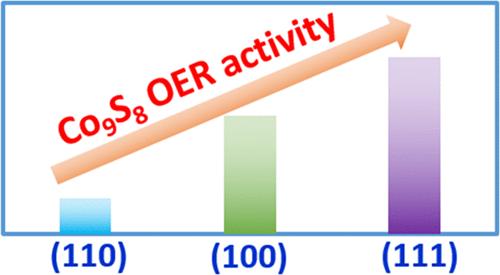Co9S8外延薄膜取向依赖的析氧催化性能及机理研究
IF 4.7
2区 化学
Q1 CHEMISTRY, INORGANIC & NUCLEAR
引用次数: 0
摘要
硫化钴(Co9S8)纳米材料由于其独特的性质和电子结构而表现出高效的电化学催化性能。不同晶向外延Co9S8薄膜的制备及其催化动力学和机理的研究仍有很大的空白。本研究利用脉冲激光沉积技术在掺钇氧化锆(YSZ)衬底上制备了取向为(100)、(110)和(111)的Co9S8外延薄膜。表征证实了它们的单晶性质和一致的厚度。电化学测量表明,所有膜的析氢反应(HER)性能相似,但析氧反应(OER)性能存在显著差异。(111)取向表现出最好的OER活性,在1.8 V vs RHE下电流密度为24.2 mA cm-2,优于(100)和(110)取向,分别达到14.5和6.7 mA cm-2。密度泛函数理论(DFT)计算表明,(100)取向有利于传统的四电子转移机制,具有较低的理论过电位(0.37 V),而(110)和(111)取向表现出更复杂的吸附行为,其过电位分别为0.49 V和0.29 V。这些结果突出了不同Co9S8晶体取向的独特反应性,为优化催化剂设计以提高OER性能提供了有价值的见解。本文章由计算机程序翻译,如有差异,请以英文原文为准。

Orientation-Dependent Oxygen Evolution Catalytic Performance and Mechanistic Insights of Epitaxial Co9S8 Thin Films
Cobalt sulfide (Co9S8) nanomaterials exhibit an efficient electrochemical catalytic performance due to their unique properties and electronic structure. The preparation of epitaxial Co9S8 thin films with varying crystal orientations and the study of their catalytic kinetics and mechanisms remain significant gaps. This study addresses the preparation of epitaxial Co9S8 thin films with orientations of (100), (110), and (111) on yttrium-doped zirconia (YSZ) substrates using pulsed laser deposition. Characterization confirmed their single-crystalline nature and consistent thickness. Electrochemical measurements revealed a similar hydrogen evolution reaction (HER) performance across all films but significant differences in the oxygen evolution reaction (OER) performance. The (111) orientation showed the best OER activity, with a current density of 24.2 mA cm–2 at 1.8 V vs RHE, outperforming the (100) and (110) orientations, which achieved 14.5 and 6.7 mA cm–2, respectively. Density functional theory (DFT) calculations indicated that the (100) orientation favored the traditional four-electron transfer mechanism, with a lower theoretical overpotential (0.37 V). In contrast, the (110) and (111) orientations demonstrated more complex adsorption behaviors, resulting in a higher overpotential of 0.49 V and a lower overpotential of 0.29 V, respectively. These results highlight the unique reactivity of different Co9S8 crystal orientations and provide valuable insights for optimizing the catalyst design to enhance the OER performance.
求助全文
通过发布文献求助,成功后即可免费获取论文全文。
去求助
来源期刊

Inorganic Chemistry
化学-无机化学与核化学
CiteScore
7.60
自引率
13.00%
发文量
1960
审稿时长
1.9 months
期刊介绍:
Inorganic Chemistry publishes fundamental studies in all phases of inorganic chemistry. Coverage includes experimental and theoretical reports on quantitative studies of structure and thermodynamics, kinetics, mechanisms of inorganic reactions, bioinorganic chemistry, and relevant aspects of organometallic chemistry, solid-state phenomena, and chemical bonding theory. Emphasis is placed on the synthesis, structure, thermodynamics, reactivity, spectroscopy, and bonding properties of significant new and known compounds.
 求助内容:
求助内容: 应助结果提醒方式:
应助结果提醒方式:


